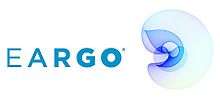Eargo
Eargo is an American hearing aid manufacturer based in San Jose, California.[1][2][3] The company's hearing aids are generally smaller and less visible than traditional in-ear devices and were inspired in their design by a fishing fly.[4] Each unit is also rechargeable.[5]
 | |
| Private | |
| Founded | 2010 |
| Founders | Florent Michel (Inventor) Raphael Michel (CEO) Daniel Shen (Co-Founder) |
| Headquarters | , |
Area served | United States |
| Products | Hearing aids |
| Website | Official Website |
History
Eargo was founded in 2010 by Florent Michel,[6] his son Raphael Michel, and Daniel Shen.[2][7] Florent—an ear, nose, and throat surgeon—serves as the designer and inventor[8] while Raphael serves as the company's CEO and Shen as the company's Chief Science & Clinical Officer.[2] Soon after founding the company, they were joined by CTO Bret Hirscher and SVP Engineering Mike Perry, who had worked with Raphael Michel nearly a decade earlier, and Chief Business Officer Matthew Welch. They received seed funding in 2013 from a range of seed funds and angels as well as Maveron.[8] In June 2015, they received $13.6 million in Series A funding from a group of 9 investors, including Maveron, Crosslink Capital, Dolby Family Ventures, and Birchmere Ventures.[1][9][10]
Eargo announced $25m in Series B funding led by New Enterprise Associatesin December 2015,[11] and in October 2017 closed the first tranche of Series C funding intended to raise $45m.[12]
The first hearing devices were made available for order in June 2015.[8] The Eargo Plus was introduced in 2017[13][14] and in 2018, the Eargo Max was introduced.[15]
Products
Eargo hearing aids are certified Class 1 medical devices. Their design is modeled after the standard fishing fly,[6] with a small speaker surrounded by medical-grade silicone fibers (for which the company uses the trademark Flexi Fibers). Unlike many other in-ear hearing aids, the Eargo apparatus is an open-canal device that does not occlude the ear canal;[6][16] the fibers allow natural bass sounds to flow more freely into the ear canal,[10][17] so that only treble ranges require amplification.[12]
The devices come in two sizes and are pre-programmed with four standard profiles.[1] To change the setting, wearers double-tap their ear, and an acoustic switch changes the sound profile. The settings for the devices in each ear can be changed independently.[6] Users can also send their personal audiograms to licensed hearing professionals at Eargo who will custom-calibrate the device for that individual's specific needs.[8] The hearing aids can be charged using a portable charging device that is sold with them, and are designed to hold a charge for up to 16 hours. The charging device itself is designed to last up to a week on a single charge.[8][5][10]
The company's founders have stated that these devices are designed with younger people in mind to overcome the stigma surrounding standard, bulky hearing aids.[7][13][18][19][20] The product designer is Ammunition Design Group, which modeled the shape of the charger on a river rock and designed it for ease of use and high visibility of the hearing aids within; the company logo is based on a visualization of a digital recording of Florent Michel saying "Eargo".[13]
References
- Magee, Christine (25 June 2015). "With $13 Million From Maveron, Eargo Is The Hearing Aid Of The Future". TechCrunch. Retrieved 27 July 2015.
- "Eargo". www.crunchbase.com. CrunchBase. Retrieved 27 July 2015.
- "Eargo Secures $13,000,000 Series A Financing Round". www.Xconomy.com. Xconomy. Retrieved 27 July 2015.
- Lee, Tyler (26 June 2015). "Eargo Could Be The Hearing Aid Of The Future". UberGizmo. Retrieved 27 July 2015.
- Sarrell, Matthew D. (4 August 2015). "Eargo Hearing Aids". PC Magazine. Retrieved 3 September 2015.
- Parvez, Husain (26 June 2015). "Eargo Is The Heading Aid Of The Future: Backed By $13 Million From Maveron". TechVoize. Retrieved 27 July 2015.
- "Innovative hearing aid Eargo available for order". Yahoo. 25 June 2015. Retrieved 27 July 2015.
- Sherman, Michael (25 June 2015). "Maveron-backed Eargo looks to reinvent the hearing aid with rechargeable devices modeled on a fishing fly". GeekWire. Retrieved 27 July 2015.
- "June 25, 2015 - Funding Round - Series A". www.crunchbase.com. CrunchBase. Retrieved 27 July 2015.
- Perenson, Melissa (25 June 2015). "Hands-on with Eargo, a New Approach to Hearing Aids". Wearables Insider. Retrieved 27 July 2015.
- "Eargo Raises $25M in Series B Funding From New Enterprise Associates". Reuters. 2015-12-09. Retrieved 2015-12-10.
- Al Idrus, Amirah (2017-10-20). "Eargo pulls in first tranche of series C round worth up to $45M". FierceBiotech.
- Budds, Diana (2017-10-13). "Ammunition Designs Slick Hearing Aids For People Who Don't Want Hearing Aids". FastCo.Design.
- "Eargo Plus Hearing Aid Review". www.hearreview.com. Retrieved 2018-08-14.
- "A Hearing Aid Meant for the Masses: The 50 Best Inventions of 2018". Time. Retrieved 2019-11-18.
- Huang, Ruochen (30 July 2015). "Investments For Hearables Surge". TechCrunch. Retrieved 4 September 2015.
- "Eargo is all about that bass… and that mid-range, and the treble". Medical Plastic News. 30 June 2015. Retrieved 27 July 2015.
- Dunhaime-Ross, Arielle (24 August 2015). "Can technology make a hearing-centric world more accessible?". The Verge. Retrieved 5 September 2015.
- "Eargo Hearing Device". Hearing Tracker. 2015. Retrieved 5 September 2015.
- Kim, Jiwon (2017-10-18). "Hearing Aids Reinvented To Make Them More Wearable For All". PSFK.